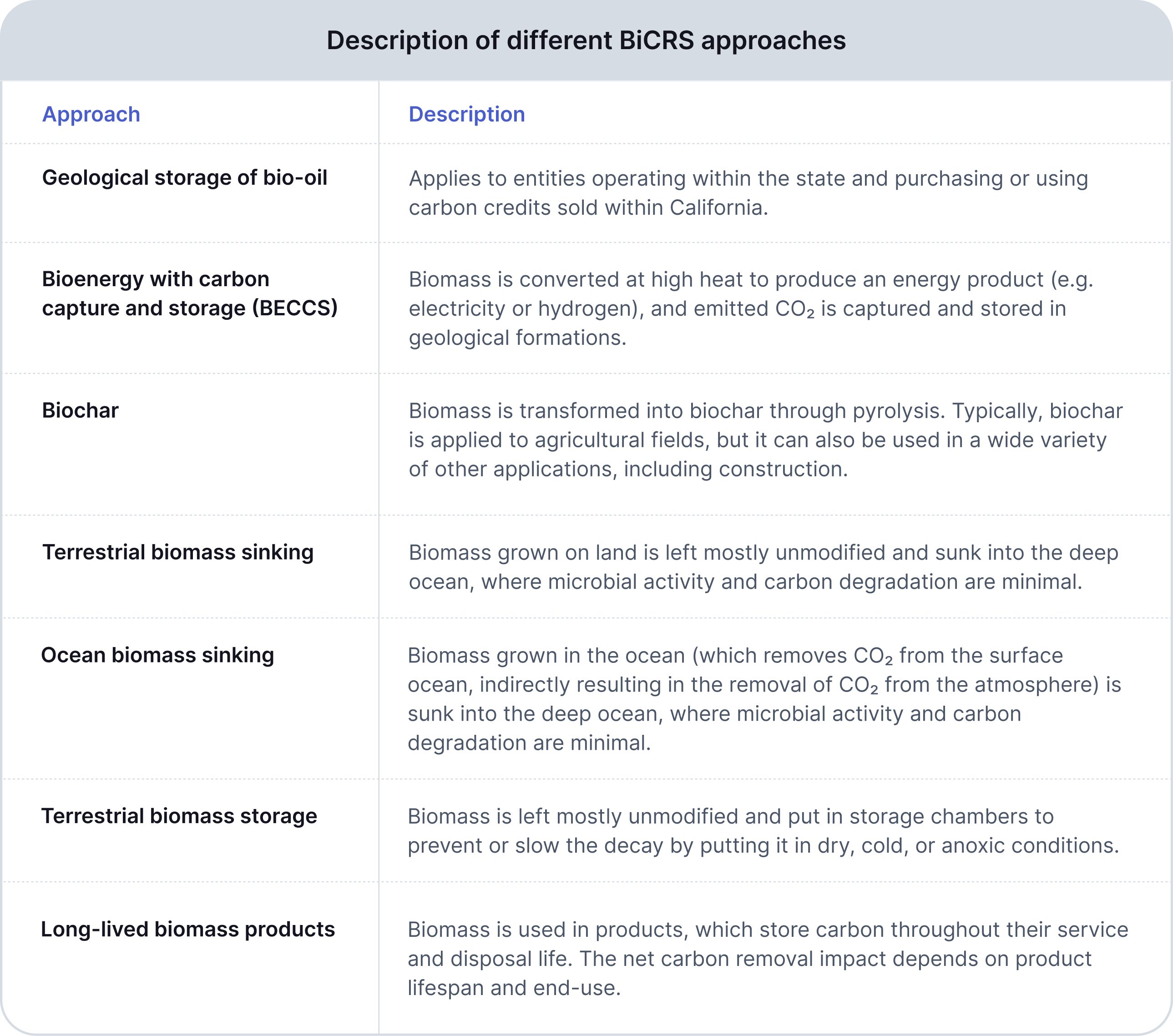Imagine if nature-based solutions suddenly become permanent. This is precisely what biomass carbon removal and storage (BiCRS) achieves. Plants capture and release hundreds of gigatons of carbon through the natural carbon cycle into the atmosphere annually. BiCRS solutions intervene in this cycle, taking carbon that would have otherwise rejoined the atmosphere and placing it into more permanent storage. Examples include biochar, bio-oil with underground storage, biomass burial, or bioenergy coupled with carbon capture and storage (BECCS).
The potential of BiCRS is significant, with a capture and storage potential between 2.5 and 5 Gt annually by 2050. Of the various BiCRS approaches available, most are cost-effective relative to other permanent carbon removal options and scalable given the amount of waste biomass feedstock available. Coupled with the potential co-benefits arising from most of these pathways, carbon credits created from such methods are highly suitable for corporate climate action. Given the attractive price point, cost, and verifiability of BiCRS credits, projects are particularly interesting for buyers pursuing net-zero targets in the next decade.
In this article, we explore the role of biomass in the voluntary carbon market (VCM), compare different BiCRS solutions, and outline the risks to be aware of. High-level insight into pricing and credit differences will also be discussed, as well as how to access high-quality BiCRS credits through CEEZER.
What is biomass and the natural carbon cycle?
Biomass refers to the organic matter of living organisms such as trees, crops, seaweed, or even municipal waste. To build up biomass, biological capture of CO2 occurs through photosynthesis, where carbon is removed from the atmosphere and stored in the plant cell. During the natural process or the “business-as-usual” scenario, much of the carbon absorbed by the living biomass is again released due to plant decomposition, fires, or human activity (deforestation).
While the natural carbon cycle is effective at capturing carbon from the atmosphere, nature-based sequestration is generally temporary and susceptible to reversal and carbon release. Stored carbon can become permanent when the biomass is removed from exposure to the atmosphere and either modified to store carbon and/or placed in environments where release can be prevented.
How does BiCRS contribute to carbon dioxide removal (CDR)?
Intervening through BiCRS allows for long-term carbon storage and breaks the natural carbon cycle. This "hybrid" approach combines the power of plants with smart engineering to create a powerful tool in the fight against climate change.
So then, what is BiCRS specifically? It is a relatively new class of carbon dioxide removal (CDR) technologies, which includes a broad set of approaches that utilize biomass to capture and store atmospheric CO2.
In the report that coined the term, BiCRS is characterized by:
- The use of biomass to remove CO2 from the atmosphere
- Storage of CO2 underground or in long-lived products
- Does not cause damage to—and ideally promotes—food security, rural livelihoods, biodiversity conservation, and other important values
If implemented correctly, BiCRS is a tool that can affordably and effectively store carbon over multiple centuries while having broader positive social and environmental impacts.
Assessing the different BiCRS pathways
BiCRS pathways may be differentiated by the type of biomass used or, more prominently, by how it stores the carbon. The table outlines the most common methods in the market today and how they differ. While depicted as individual technologies, BiCRS projects may employ a combination of technologies, approaches, or biomass feedstocks.
Table 1: Description of different BiCRS approaches

The table provides more details on the storage mechanism, the technological readiness of the approach as well as the level of confidence in quantifying the net carbon removal and storage durability of each BiCRS approach. In addition, it shows the technological readiness level and verification confidence level of each approach.
Table 2: Different BiCRS approaches and their permanence and readiness
.png)
The table above offers a simplified comparison of different BiCRS on various metrics, using sources with scientific rigor and breadth of analysis. Nevertheless, other relevant sources may reach slightly different conclusions or adopt other terminology. For example, Carbonplan assigns a verification confidence level (VCL) rating of 1-3 to biochar applied in soils, which arguably is relatively low considering the maturity of the technology within the carbon removal space.
On top of the above, the solutions differ in terms of different parameters, such as co-benefits. For instance, BECCS can supply baseload energy, while biochar can result in increased crop yields and resilience to drought. It is vital to take into account these effects beyond carbon when devising a carbon credit procurement strategy.
Where to purchase BiCRS credits and what’s their availability in the market?
BiCRS credits have gained significant traction in the carbon removal market. In 2023, out of the 4.5 million tCO₂e CDR purchased, BECCS dominated with a 63% share followed by direct air capture (20%), biochar (7%), enhanced rock weathering (4%), and bio-oil (3%). However, the delivery landscape tells a different story. Biochar accounted for 94% of CDR deliveries in 2023. This highlights the readiness and short-term scalability of biochar and other BiCRS subcategories compared to more expensive technologies such as DAC.
Government agencies recognize the potential of BiCRS. The US Department of Energy estimates that BiCRS could remove over 800 MtCO₂ annually in the US without compromising cropland or commodity prices. Globally, biochar alone has the potential to eliminate up to 6% of annual global greenhouse gas emissions.
To help businesses navigate this market, the table below provides an overview of available BiCRS credit types and their indicative price ranges.
Table 3: Different BiCRS approaches and their market availability
.png)
The BiCRS market, although nascent, is poised for rapid growth as projects come to fruition, technologies advance, and demand surges. In the long term, the most competitive BiCRS solutions will be those that can source and transform biomass sustainably, efficiently, and cost-effectively.
While biochar leads the way, most other BiCRS solutions are still considered novel, with their full potential yet to be realized. Due to their inherent carbon capturing efficiency through photosynthesis, even approaches with lower technology readiness levels are often available at substantially lower price points than fully engineered solutions like direct air capture (DAC).
As businesses navigate this evolving landscape, staying informed about the latest developments in BiCRS technologies, pricing, and availability will be crucial for making strategic decisions and effectively participating in this burgeoning market. By understanding the availability and pricing of BiCRS credits, businesses can make informed decisions when entering and participating in this rapidly growing market.
The good and the bad of BiCRS projects
While BiCRS projects offer an appealing carbon removal opportunity, some externalities must be considered during vetting. Specifically, assessing the robustness of carbon accounting and the sustainability of biomass sources is critical.
Sourcing sustainable biomass is a complex issue, and will grow more thorny over the coming decades as demand for bioenergy is growing in all IEA member countries. Biomass is a finite resource with a diverse application range (including novel applications like bioplastics, animal feed, sustainable aviation fuel, and electricity generation) that is expected to grow, and careful consideration is needed to make informed allocation decisions.
A significant supply-demand gap emerges when we consider the potential bioeconomy of 2050 and analyze the diverse applications for biomass. Biomass demand is expected to double by 2030 with many countries relying on international supply to meet regional demand. In Germany, If the energy sector continues to operate as is, biomass demand for energy use will outstrip domestic supply by 70% in 2030. By 2050, the EU is expected to experience a 40-70% supply-demand gap that imports must fill. While a large disparity between local demand and supply is expected, on a global scale we will be able to reach sustainable biomass supply.
By leveraging sustainable sources of biomass from agricultural waste in the tropics, projects have the potential to address the supply-demand gap of biomass as well as contribute to sustainable development in these regions. Recent research quantifies the potential contribution biochar can make toward carbon removal assuming the use of only sustainably supplied biomass, i.e., residues from existing agricultural, livestock, forestry, and wastewater treatment operations.
As usage of biomass scales, ensuring that rigorous checks are in place to reduce the risk of negative externalities is crucial. The United Nations Framework Convention on Climate Change (UNFCCC) warns that “poorly implemented [BiCRS] can negatively impact on local livelihoods and indigenous peoples' rights, especially when implemented at large scale and where land tenure is not clearly defined.” Failure to address these issues can lead to unintended environmental consequences and undermine the effectiveness of BiCRS projects in reducing atmospheric CO2 levels.
To mitigate such negative externalities, extensive risk assessments of projects, project developers, and the host country are needed. Explaining a methodology that collects more than 500 data points, our white paper “Assessing carbon credit risk—a market perspective” provides a screening framework and project profile to buyers who want to deepen their knowledge of risk drivers and exposure. CEEZER's due diligence process meticulously evaluates biochar and other biomass projects, ensuring the process is truly net-negative. Below are some indicators we specifically look at for BiCRS projects.
Table 4: Selected examples of risk factors relevant to BiCRS projects
.png)
CEEZER facilitates the procurement of high-quality biomass carbon removal
As a potentially affordable and energy-efficient way of permanently removing CO2 from the atmosphere, BiCRS has immense potential. Yet, scaling is limited due to insufficient financing of production. Carbon removal credits can help mitigate the financing gap, improving this project type's economic feasibility and awareness. If effectively developed, regulated, and monitored, BiCRS could contribute to CO2 removal at the gigaton scale while supporting sustainable development. However, potential challenges, such as land-use competition and sustainability issues related to biomass use, must be carefully considered when vetting a project.
CEEZER facilitates a trusted and direct relationship between project developers and forward-thinking organizations. As the BiCRS market matures, and the need for net-zero intensifies, these projects will drastically increase in demand.
If you are interested in partnering with CEEZER as a developer of a high-quality project or as a forward-thinking organization, please contact us.
We would like to thank everyone who contributed and provided feedback (by alphabetical order): Hedda Björk (Planboo), Mart de Bruijn (Carboneers United), Christopher Knop (Carbon Sequestration), Kenneth Möllersten (Reverse Carbon/KTH Royal Institute of Technology), Peter Ralph (University of Sydney), Fabian Sperling (Carbonsate).
Contact us to learn more or schedule a demo call to explore the possibilities.
.jpeg)
.jpg)



